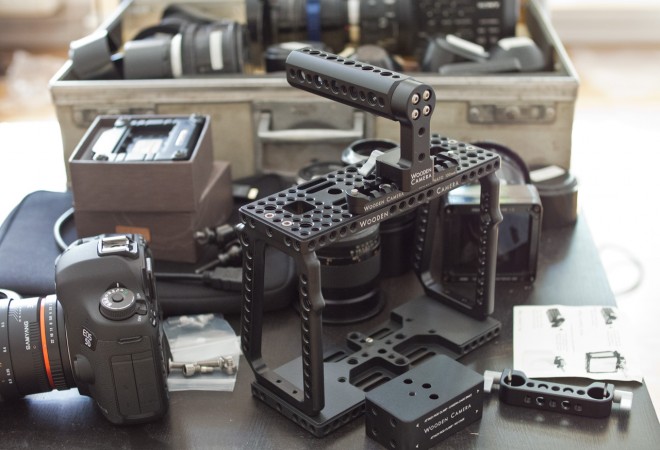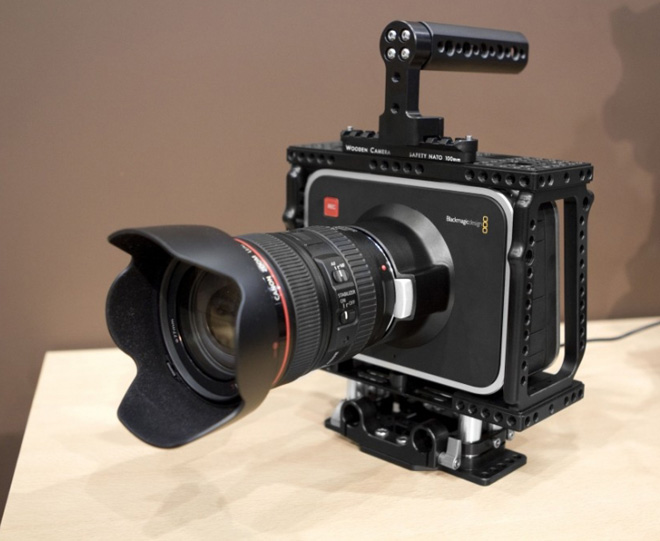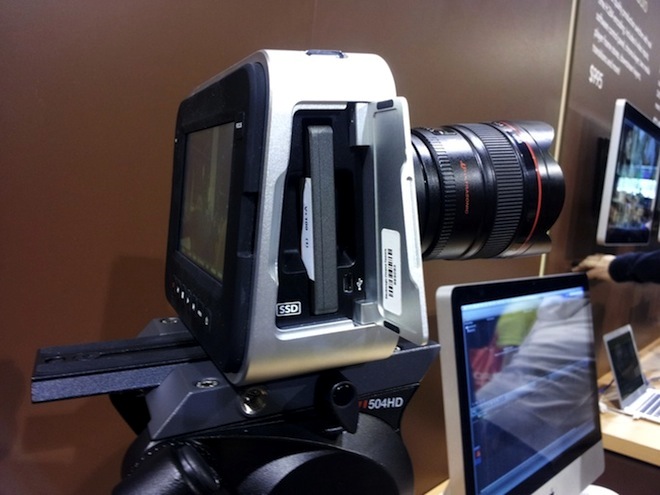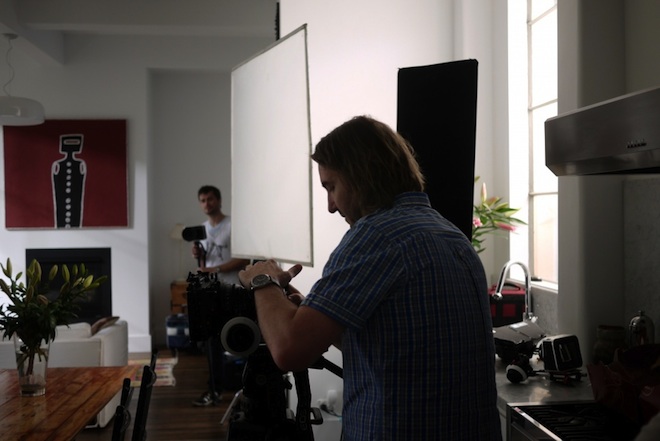There’s some debate at the moment around the Blackmagic Cinema Camera and how useful the raw recording mode is. For me it is ground-breaking at this price point but it seems not everyone sees it with the same enthusiasm because of the workflow and storage requirements. Some say raw is time consuming, not practical, or clients don’t need it.
There is no single answer to this which suits everyone, or every shoot. If someone says that their current clients don’t need raw and they don’t see an advantage to working with raw video – then they are absolutely right to believe that. If someone tries to tell you that their opinion on this is the ultimate and final voice on the matter, they are wrong. Personally I am in favour of raw for what I do (this opinion is based on my own needs).
But part of the reason I am coming down so heavily in favour of raw myself is not just because of me – it is because I can see some less obvious benefits to work that many would be dead-set on shooting with ProRes in-camera.
“My clients don’t need it”
Your future clients might. So it helps to be prepared.
Have a raw workflow ready for when you might need it. Invest the time and effort into that. Now is a good time to figure this out, as many are doing with the Blackmagic camera as it is so new.
“I don’t need it”
Your future self might do.
Maybe tomorrow on a project shot only in ProRes mode – So why box yourself into ProRes by baking it at 1080p in-camera?
If you are new to glorious 2.5K raw think about how valuable it is to have this opportunity to learn about raw. At just $3000 this is new territory.
Raw video workflows (not to mention grading raw in DaVinci Resolve) are still a useful and valuable filmmaking skill to pick up and learn.
“The overheads and extra time make it uneconomical”
Some clients are happy to pay more for better image quality if they realise the benefits. Some understand the benefits of raw too, not just in terms of image quality but in terms of the shoot and the ability to fix problems in post. Some request the source footage after the project is delivered. Giving them it in raw allows them to give it to someone else later to grade and make extensive changes in that grade not possible with 1080p ProRes.
You can often charge more for a raw shoot, for good reason. Sure it isn’t for all clients but there’s a reason for all those Red bookings.
They don’t all just come from the narrative filmmaking world or the indie filmmaker. Some clients want raw and are happy to pay for it.

My Wooden Camera cage for the BMCC
“Image quality is not a priority”
Raw recording on the Blackmagic Cinema Camera gives you the ultimate image quality from that camera. 12bit colour, 13 stop dynamic range and 2.5k resolution exceed what you get in 10bit 1080p ProRes.
Why compromise?
Even if delivering for the web or Vimeo in compressed 720p, the raw workflow has major advantages for dynamic range and workflow (see pros and cons section) both creative and practical. I’ll get to those in a moment.
“ProRes has advantages”
It sure does. I’m not denying this isn’t a great feature too and that it will be useful for a lot of shoots.
Raw frames are similar in size to the raw stills you get from a DSLR, roughly 3-5MB depending on what is in the shot. When you activate ProRes in-camera you will fit more footage on one SSD during the shoot, be able to drop the ProRes straight into an NLE and deliver your video to a client as quickly as possible. No transcoding.
“Raw is not convenient”
Raw aqusition is convenient. More expensive? Quite possibly – you will just need to buy more SSDs if your shooting day is long, or you aren’t able to empty the SSDs onto HDDs for an extended period.
Raw workflow on the other hand is as inconvenient or as convenient as you want it to be.
I tweeted one of my basic workflows in less than 160 characters!
“Here’s a Blackmagic raw workflow: Drag DNGs into AE. Full recovery on highs and lows. Render queue. 2.5K H.264 80Mbit. Premiere. Not hard is it?”
Imagine the excitement at 2.5K H.264 80Mbit ALL-I on a DSLR? Now you can have it from the Blackmagic Cinema Camera and avoid editing the raw files by proxy at all. You still get the extended dynamic range and resolution of the raw files though, all in that compact and easy to edit DSLR codec.
What I don’t understand is why people want to enable ProRes on the camera when they can have ProRes later and delete the raw masters, or even 80Mbit H.264 at 2.5K resolution after just a few hours of transcoding.
THAT is convenient.
Also SSD prices are coming down constantly, and capacities going up steadily. People should always look to the future with these things…
Photo by Illya Friedman for EOSHD (The camera first arrived at NAB in 2012)
“People won’t notice the image quality increase from a raw workflow”
2.5K is a significant increase in resolution from 1080p and allows you to re-frame in post for creative reasons or to fix a problematic shot. This can save an entire shoot.
Crews often shoot ProRes on an Alexa for 1080p content delivery, like TV and web for instance. But these crews spend a hell of a lot of money making sure everything goes right on the shoot and then a hell of a lot of money moving $20,000 worth of Arri lights down the street attached to a generator. Then they go and shoot it all in ProRes.
For those on a smaller budget, you can think differently and a little bit smarter. Raw can actually save you money because a great deal of the higher end budgets are spent simply to ensure zero risks – if colour temperature or skin-tones or exposure are even slightly off on location or the lighting you are given on location is sub-optimal, the lighting technician and DP goes round re-ligihting the location and spending hours over doing so. But with a small budget, small crew and raw, you can easily fix the minor lighting issues in post which is far quicker and far cheaper.
This doesn’t mean to say you don’t have to worry about lighting, natural or otherwise. If your light is badly done, your image will be flat and rubbish whether you shot it on an iPhone or an Alexa.
Transcode / sleep
Again that workflow is not a problem. Minimally, batch convert your graded (or flattened) raw files to whichever format you choose be it H.264 or ProRes LT or ProRes HQ. Leave the computer running over night. Hell, leave two computers running! It will be done by the morning. If you didn’t shoot much and you have a CUDA card ($200) it might even be done after a trip to the pub.
The most time consuming part of that raw workflow happens whilst you’re asleep – or drunk!
As I am a filmmaker who prepares my own projects and someone with a lot of say in how these projects are done, I don’t worry about having to deliver corporate videos to a customer with a tight deadline. I’ve spent so much effort on my career to make sure I avoid becoming just another DP on a corporate video. I could have taken that route but chose not to. EOSHD is a big part of this. But even in the harshly paced world of corporate videos it is rare you will do a job that doesn’t even allow you the luxury of SLEEPING.
Dump the footage to HDD
At the end of each shooting day you can dump the SSDs to HDDs and free the more expensive media up for the next day’s shoot. Raw acquisition gives you so many benefits in post, and if you don’t need to act on them, you can magically change it all to ProRes and forget you ever shot raw in the first place.
“Grading raw is a hassle”
Maybe learning DaVinci Resolve is a hassle when you just want to get on with the Fast Color Corrector in Premiere and have a deadline the next day. I can certainly sympathise with that. Those new to a workflow will be reluctant to find the time in a tight shooting / editing schedule for a workshop in Resolve. That would take a lot of resolve!
But raw doesn’t need to have a LUT applied or any grading at all if you don’t have time to. You don’t even have to touch it, you can always just transcode to ProRes or edit by proxy on a timeline in Premiere and use the Fast Color Corrector!
It isn’t like a flat image profile or CineStyle. It isn’t the same as LOG.
But immediately, once you start editing those transcoded files in whatever format you choose be it H.264 or ProRes LT or ProRes HQ 4:4:4 you have that safety net of the original raw files to fall back on or better grade a shot if you need to. By shooting ProRes in camera, you don’t have that safety net.
“Archival is a nightmare!”
Once the project has gone cold, is delivered and a few months old, you can free up HDD space by converting the raw masters to ProRes (or H.264) and then deleting the the DNG files. Coming back to an archived project files in 6 months and making major changes to grading, white balance or ISO is very unlikely. Of course if it is a film you have put all your blood sweat and tears into for years and it is doing the festival rounds, it makes sense to keep the raw masters. Some creative works are more important than saving $300 on a hard drive.
Conclusion – sometimes creativity is king not time and money
Quite apart from the safety net of raw and ability to fix stuff – what about the creative benefits of raw and the affect it has on the image?
These are sizeable advantages and I am surprised with how many content producers and filmmakers are willing to overlook the artistic and image quality benefits of raw, for the sake of saving a few hours in the edit suite or some hard disk space. What a cynical bunch!
Blackmagic have given us artists a wonderful tool here – for $3000. Incredible. In grading the image, raw stands up better than ProRes and you can do more with it. The superb DaVinci Resolve was made for this, and even the simple Photoshop Raw controls which After Effects CS6 uses gives you full access to the power of raw. You can go as simple on post or as complex as you like.
If for example your video is only 720p, you can do some creative re-framing, some Warp Stabliser and even a digital zoom on the 2.5K raw. Even if your end project is 1080p you still have quite a few options there. With ProRes you have zero options there that don’t degrade and soften the image.
In terms of white balance you might light on the day for a very warm look, then decide you want a much cooler look later. With ProRes you will be re-shooting it with cooler lights and cooling filters. With raw you will be flicking a switch in post. Now tell me ProRes saves time.
Pros and cons
Raw
+ Ultimate 2.5K resolution and detail for $3000
+ 13 stop dynamic range
+ 12bit colour, better for skin tones and smoother gradients
+ The skill and learning experience of raw workflow and grading is extremely valuable to people shooting raw for the first time
+ The best codec for green screen keying work and VFX
+ Re-framing ability (creative and to fix) from 2.5K if final content delivery is 720/1080p
+ Extensive exposure controls in post (creative or fix)
+ Extensive white balance controls in post (creative or fix)
+ Better for extreme grades and applying an extreme look in post
+ DaVinci Resolve bundled with camera – superb software for a raw workflow
+ Some clients willing to pay more for a raw shoot and source footage, check Red Epic day rates compared to 7D
+ Often less time and worry during the shoot. You won’t be worrying about white balance or ISO for example
– Requires more acquisition media capacity. 480GB (or $350) good for 1 hour of footage
– Dump to HDD required more often
– More HDD space required (cheap for 1 shoot, but extensive archival or multiple shoots in one week not so cheap)
– Transcoding required / edit by proxy (cannot just drag and drop into FCP / Premiere)
ProRes
+ Fits most current industry standard workflows like a glove
+ Instant, native editing of master footage in all the common NLEs
+ Less demanding on SSD write speeds in-camera, less risk of dropped frames on inferior drives
+ Requires less acquisition capacity, saving on premium media like SSDs
+ Requires less HDD archival capacity – HDDs are cheap but significant money saved over long periods of time
+ Still better than any DSLR codec at time of writing – more dynamic range and cleaner in the lows especially
– Less creative wiggle room
– Far less able to fix a problem shot in post, less of a safety net
– More time spent on set perfecting camera settings and re-lighting
– Less resolution, worse overall image quality compared to the raw recording mode
– Not as good for VFX work as raw
– Why spend all that money on the shoot and not shoot it in the best image quality possible?
– Little or no re-framing capability
– You won’t learn raw if you never use it
Summary
I feel that right now amongst many working videographers the benefits of ProRes are more widely understood than raw. In TV production, low budget production, DSLR shoots, corporate videos – ProRes is well used already. Raw exists in the world of Red and Arri but even most Alexa shoots use ProRes only!
This is the first time we’ve ever had raw video at the $3000 mark which is basically a consumer price level and accessible for those hundreds of thousands of 5D / 7D shooters and aspiring filmmakers out there.
Many people’s first taste of raw will be on the Blackmagic Cinema Camera and they should not default to ProRes without giving it some time, effort and learning first even if it isn’t for their current work it may be useful later. There’s significant skills and image quality at stake here. Should you choose to ignore raw, you’ll be missing out.





